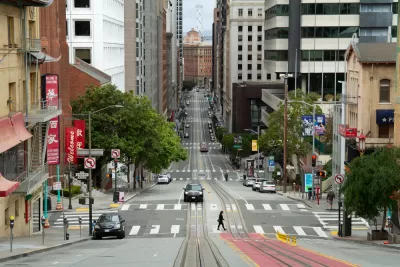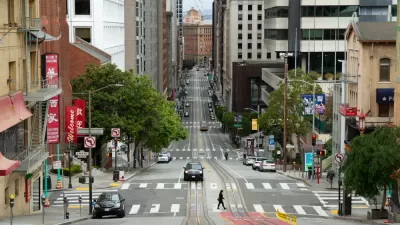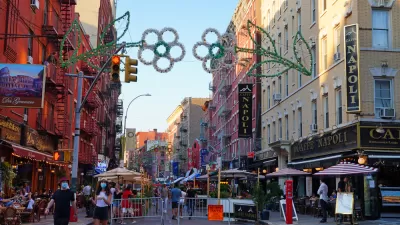“Downtown on the Brink” reads the headline of a recent San Francisco Chronicle feature.

Some Downtown San Francisco storefronts are still shuttered and graffitied, but some signs of life are returning to the streets as professionals and tourists return to the city’s famous urban neighborhoods. But the city’s Downtown is far from back to normal, and big changes will be necessary to avoid a “general economic decline,” according to a big interactive feature published recently by the San Francisco Chronicle, written by Noah Arroyo with visual supplements by Jessica Christian.
“Before the pandemic, office work was responsible for a whopping 72% of the city’s gross domestic product, according to the Controller’s Office — work that was heavily concentrated in the Financial District, the Market Street corridor, the Embarcadero and Mission Bay,” writes Arroyo.
Various metrics indicate Downtown San Francisco is far from recovered from the effects of working from home and social distancing. Office Space vacancy is up from 4.8 million square feet in the first quarter of 2019 to 18.7 million square feet in the first quarter of 2022, according to data presented in the article. That’s the highest level of office vacancies since the Great Recession. Convention attendees have dropped from 221,500 to 30,300 in the same period, and BART exits are down from 9.8 million to 2.3 million. Sales tax revenue in 2021 dropped to 33.5 million, compared to 55.6 million in 2019.
More data is included in the source article, with discussion of these trends focused on the effect for the city’s coffers, local businesses that operate in downtown neighborhoods, and public safety. The article also, however, asks “city planners, businesses and residents” what they will do in response.
“City officials and business leaders are working together, understanding that unless the city can defy national remote-work trends, its economic core will be forever altered,” writes Arroyo. So far, the San Francisco Office of Economic and Workforce Development is working on a strategy to bring the city’s economic core “back to life,” according to the article, but so far, city officials are taking a wait-and-see approach.
“It’s a bit premature for us to share specifics at this stage,” said Gloria Chan, the office’s director of communications, in an email to the Chronicle.
FULL STORY: Downtown S.F. on the brink: It’s worse than it looks

Alabama: Trump Terminates Settlements for Black Communities Harmed By Raw Sewage
Trump deemed the landmark civil rights agreement “illegal DEI and environmental justice policy.”

Study: Maui’s Plan to Convert Vacation Rentals to Long-Term Housing Could Cause Nearly $1 Billion Economic Loss
The plan would reduce visitor accommodation by 25% resulting in 1,900 jobs lost.

Planetizen Federal Action Tracker
A weekly monitor of how Trump’s orders and actions are impacting planners and planning in America.

Wind Energy on the Rise Despite Federal Policy Reversal
The Trump administration is revoking federal support for renewable energy, but demand for new projects continues unabated.

Passengers Flock to Caltrain After Electrification
The new electric trains are running faster and more reliably, leading to strong ridership growth on the Bay Area rail system.

Texas Churches Rally Behind ‘Yes in God’s Back Yard’ Legislation
Religious leaders want the state to reduce zoning regulations to streamline leasing church-owned land to housing developers.
Urban Design for Planners 1: Software Tools
This six-course series explores essential urban design concepts using open source software and equips planners with the tools they need to participate fully in the urban design process.
Planning for Universal Design
Learn the tools for implementing Universal Design in planning regulations.
Caltrans
Smith Gee Studio
Institute for Housing and Urban Development Studies (IHS)
City of Grandview
Harvard GSD Executive Education
Toledo-Lucas County Plan Commissions
Salt Lake City
NYU Wagner Graduate School of Public Service




























